How Wishpond.com Automated Their Marketing Blog for Extra Conversions
Marketing Automation Insider is supported by readers like yourself. We may earn an affiliate commission when you purchase through our links. Of course, this won't increase the cost of your subscription.
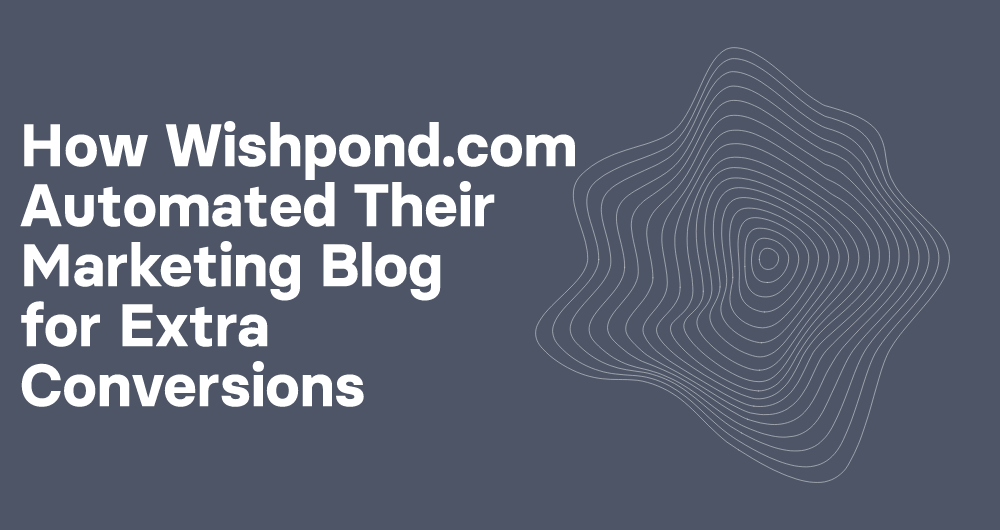
The most valuable part of a lead’s identity isn’t their name or email address, it’s what they care about.
Over the past couple months, we’ve been implementing a content-focused automation strategy at Wishpond, enabling us to show personalized blog content to each visitor based on what they care about.
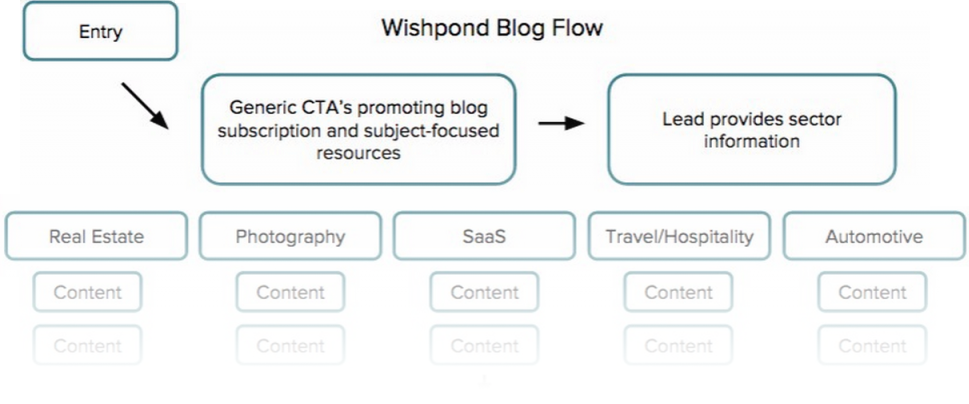
We all know that being able to deliver content that our leads are actually interested in is the basis of intelligent marketing and an optimized nurturing strategy. While many businesses are already doing this with email by integrating their CRM with email automation funnels, few are doing it elsewhere.
Let’s start simple
Everything in this article is built off a simple understanding: because of the developments in Javascript, Liquid, and cookie technology, our blogs (and websites) can be altered for each visitor based on information automatically delivered to the back end.
Who they are, what they care about, and how they prefer to consume content affects how our readers interact with our blog. Their actions and the information they give us are also used to affect how our blog interacts with them in return.
A quick breakdown to remind all of us how this works:
- Someone visits our site for the first time and a cookie is automatically attached to their browser.
- Our CRM collects the data from that cookie and creates an identity for them.
- As they interact with our site their identity is updated based on pages they visit, information they give us, and any number of other actions/events which they take.
- We can manually influence the labelling of leads/traffic by specifying certain actions/events which we deem important (the visiting of our pricing page, for instance).
- We can manually influence the identity of our leads based on a specific series of actions/events they take (heading from specific blog articles to our product page to our pricing page, for instance).
Their individual cookies trigger changes in the script of our website and blog, which can affect the look of it, the things we offer, and the way in which we promote our content and brand.
How Wishpond labels site traffic, leads and clients to automate lead nurturing
To illustrate how Wishpond labels traffic, leads, and clients, let’s take a quick look at Wishpond’s site traffic from 7 minutes ago:
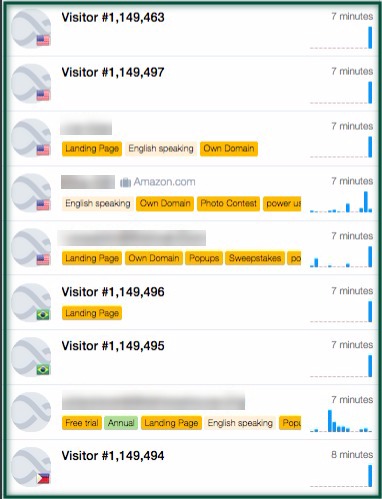
This is a list of nine people on the Wishpond.com website. Five of them are new to our site, though one of those has already been tagged with a ‘landing page’ label, as they’ve gone to a URL reading ‘landing-page’.
The others have more updated identities with names and email addresses. We know that three are English speaking (as their browsers are set to the English language). We know that one of them is interested (or has already engaged) with a photo contest, and three others are interested in landing pages, popups, and sweepstakes. Two are power users.
All of these people will eventually also be labeled with their sector (once they’ve provided us with that information) and have automated, personalized paths to conversion or retention.
Isn’t this just fancy lead-scoring?
Yes, but with a small caveat related to content. Lead scoring is awesome, but it is limited by targeting communication and nurturing leads based on their score. What we’re doing is different: it takes into account a lead’s score but also recognizes their individuality beyond that single number.
This gets back to what I was talking in my introduction: the ability to deliver content and lead nurturing communication based on what someone cares about.
For instance, not only will our marketing automation platform know that the blurred-out lead above has a score of 10, it will also know that this lead is in the real-estate industry. This knowledge allows us to specifically cater to this lead, both with intensity of communication and the content of that communication..
The key automation characteristic for Wishpond is the sector of our leads, as we’ve found it to be the best indicator of what they’re interested in (better than subject matter, for instance). That said, you could structure your content automation flows (see below) based on any criteria you choose.
Building Wishpond’s Sector-Segmented Content Marketing Strategy
As soon as we learn the sector of our leads and clients we segment them into a content flow – something like this:
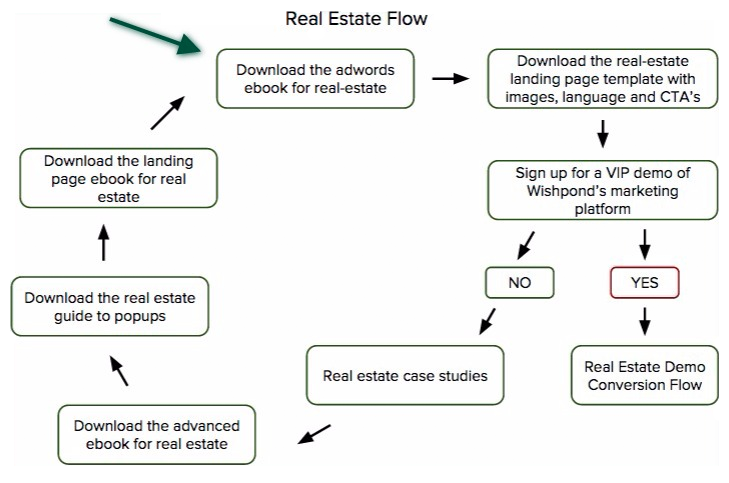
This is the flow of CTAs a lead classified under ‘real-estate’ might see on our blog. A visitor would, initially, submit lead information for one of our generic pieces of content. As soon as they tell us they’re in the real estate sector, however, they enter this flow (green arrow).
- The next time they arrive on our blog they see, instead of a generic banner, a prompt to download the Adwords ebook for real estate.
- Once they do so (or, once 72 hours has passed, whichever is first) they will start seeing a prompt for the landing page template for real estate.
- Once they’ve downloaded two ebooks (or 10 days have passed in which they’ve gone to the blog’s URL at least three times) they’ll start seeing a prompt to sign up for a VIP demo of our tools.
- If they register for a demo, we view that as a conversion from this funnel, at which point they enter our demo conversion flow, which converts them from a demo to a subscription (primarily through email).
- If they don’t convert for the demo they are put back into the continuous flow of lead nurturing (it goes without saying that any piece of content they’ve already downloaded won’t be shown again – thus the need for a large amount of content to optimally nurture leads in this way).
Our site can also recognize visitors who have already provided us with all the lead information we need, and so won’t keep prompting them for more. Instead of the full form on the right, our leads and clients would simply see the left-hand example, reducing barrier of entry and increasing value of engagement:
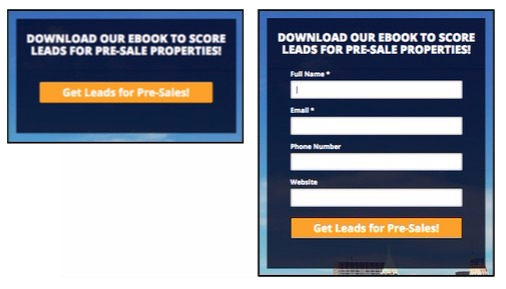
This content automation flow is paired to an optimized email automation funnel as well, which works to drive a lead towards a final conversion with personalized communication (but that’s a topic for a different article).
A fully-automated content flow:
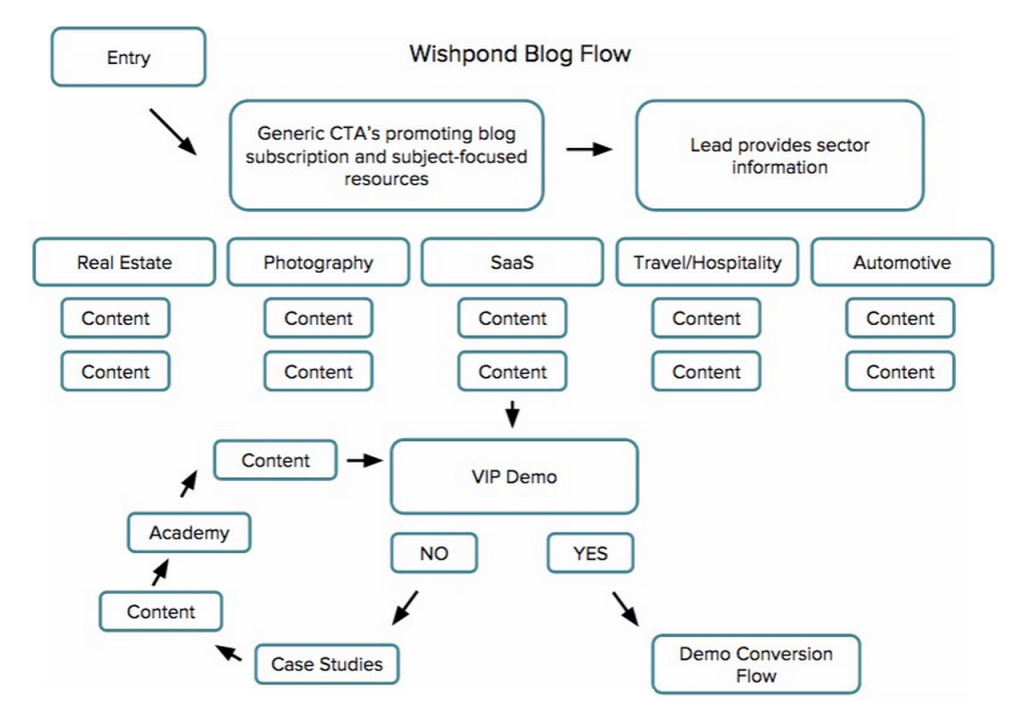
The Challenges With Sector-Segmented Content Strategy
You may have noticed that this campaign structure requires a huge amount of sector-based content, and I’m not going to pretend otherwise.
Creating content flows for your business’ top sectors is a serious task, and shouldn’t be taken on lightly. But, luckily, this doesn’t all have to be rolled out at the same time, and much of it can be recycled.
For Wishpond, since we finished creating our generic content (e.g. a series of ebooks, templates, image libraries etc.) it’s been relatively straight forward to follow the same pattern for each of our top sectors. Once we’ve completed the content for each flow we create the label, scripts, and route each lead will take, working closely with our email automation and sales team throughout.
While it may seem intimidating to begin with, once you get into it it’s more straightforward than you might expect.
The Next Phase of Automation For Wishpond
There’s no end to personalization and automation, as the paths that our leads take can be constantly optimized and tested for more conversions. New content and flows needs to be created, as we mirror the paths of our leads step-by-step.
For the main flow that I shared above, for instance, we’ll be constantly tweaking asks, CTA copy, timing and content. At the moment, our primary blog conversion is a VIP demo with one of our sales people, but we will be A/B testing it against an immediate free trial offer to determine which provides a better ROI.
But the heart of it all remains the same: maximizing our ability to anticipate our lead’s movement and personalizing (as much as technologically possible) their interaction with our business and our content. As yet, only 5-10% of SMBs have adopted marketing automation, but that number is increasing steadily as cheaper, simpler, and more intuitive platforms pop up. Want to stay ahead of your competitors? Get into it, or get left behind.
About the Author:
James Scherer is content editor for Wishpond.com, a SaaS startup providing lead generation, CRM, and (soon) marketing automation tools designed for SMBs. He is the author of The Complete Sales Funnel Guide for Real Estate.



